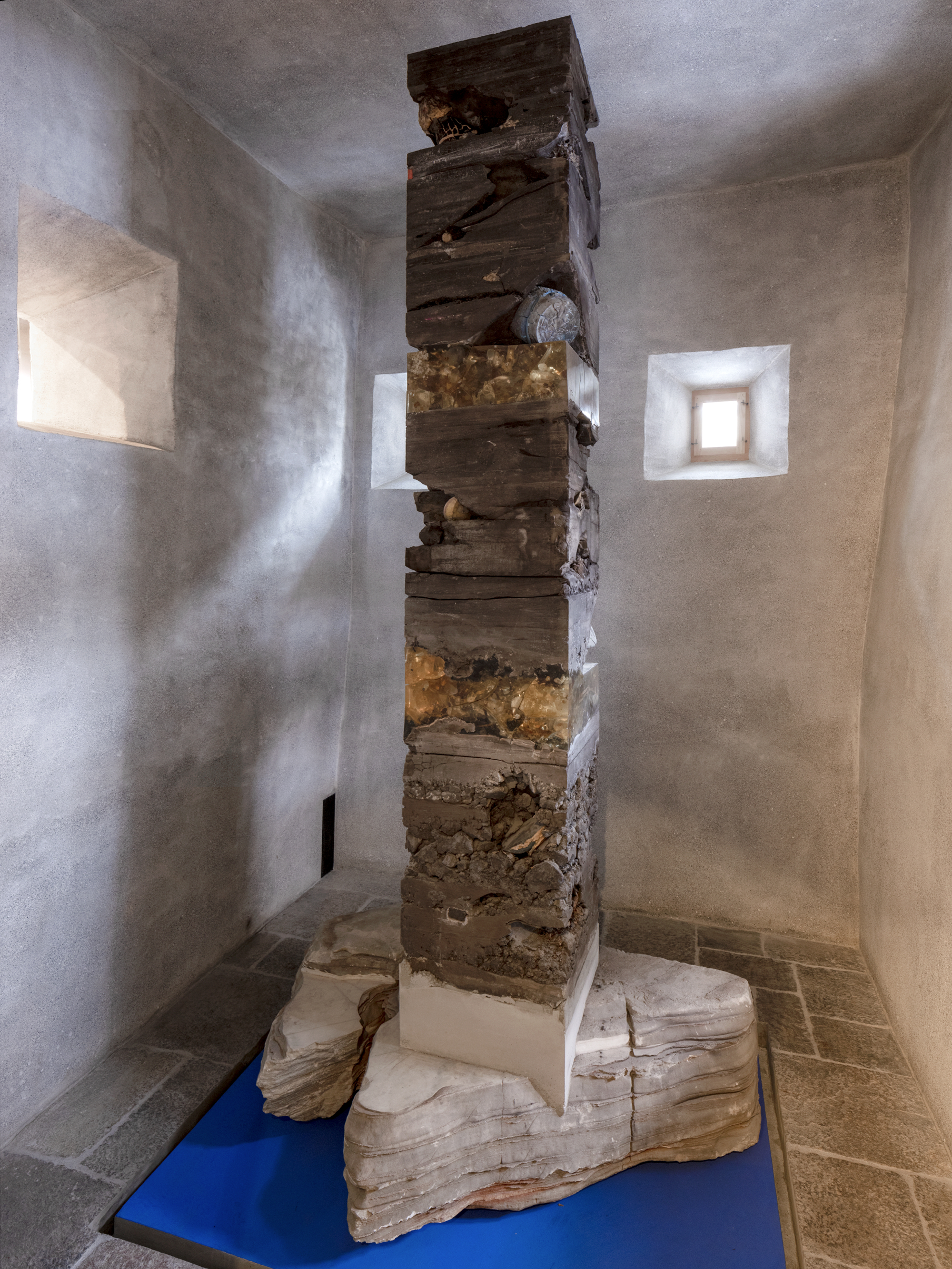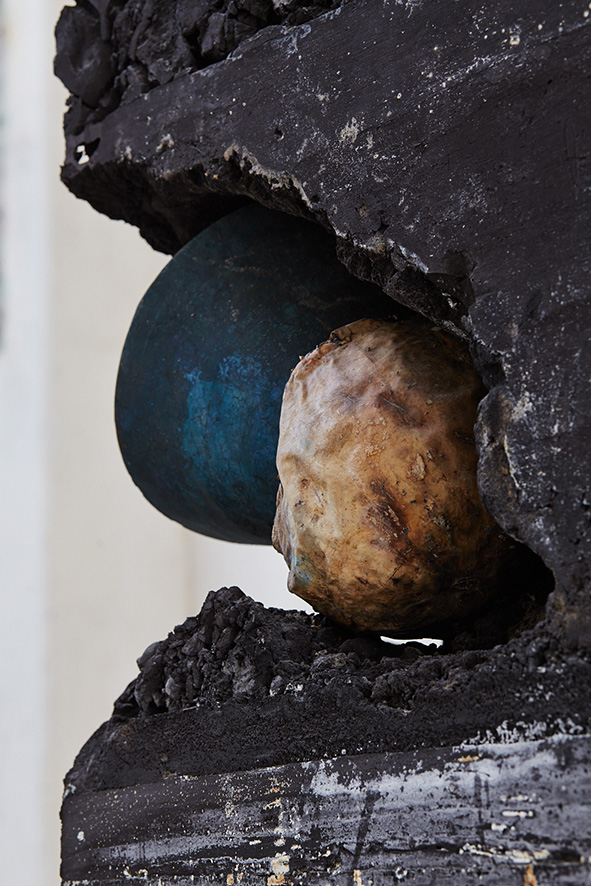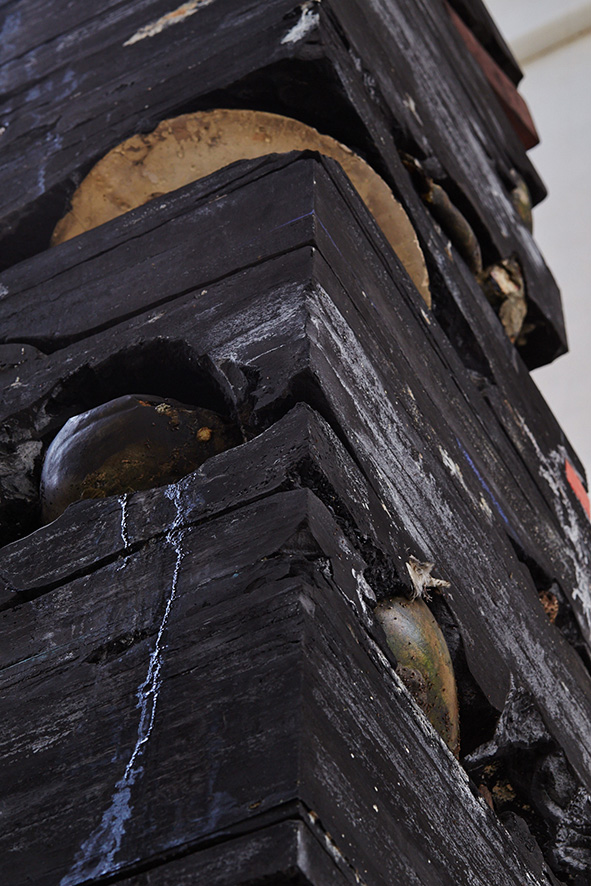↘ SITE - SPECIFIC
PERMANENT INSTALLATIONS
Adrián Villar Rojas
From the Series
The Theater of Disappearance XXXI, 2018

Widely acclaimed for his immersive environments and experiences that seem to be in a state of perpetual space-time travel, Adrián Villar Rojas’s projects conjure different temporalities from which to reflect upon the present. From a life-size whale stranded in a forest in Patagonia (My Dead Family, 2009) to a gigantic hybrid between Moche pottery and robotic junk (A Person Loved Me, 2012), the artist’s practice meets and explores materials – such as the cracked raw clay whose instability and transience triggers both an ontic and ontological play with time, accelerating it in two paradoxical ways: as a hyper entropy of its components (ephemerality) and as a hyperbolized reference to the remote past and future (permanence). Viewers’ perception is often that of being before things about to disappear or before traits from far, undefined eras, even from parallel dimensions.

Housed in the oldest part of the museum complex, which dates back to the 12th century, Villar Rojas’s commission for MUZEUM SUSCH, From the Series The Theater of Disappearance XXXI (2018), is a mesmerizing constellation of items. Resting on an intense blue concrete platform, a low boulder supports a rectangular, totem-like block. Extending almost to the ceiling, its layers of varying texture and hue are encrusted with a medley of vernacular materials and objects, both organic and synthetic, gathered after deep and sustained research in local contexts in order to respectfully grasp their geographical, urban and cultural singularity. From sea snail shells, fish, sands, soils, corals and animal bones to industrial and handcrafted products, seeds, abandoned nests, fungus, minerals, all kinds of vegetables, plants, and even dead small birds or insects. These earthly things are often manipulated and reconfigured by Villar Rojas, as is the case with the hybrid assemblies – mixing twisted colorful sneakers and seashell arrangements – delicately encrusted inside the columns. Villar Rojas will spend months visiting local people and academics, markets, nurseries, historical sites, factories, craft workshops - in fact, any place he is guided to by locals or happens to meet by serendipity.
This commission’s origins lie in a series of four distinct exhibitions, held between 2017 and 2018, under the same umbrella title, The Theater of Disappearance, at Kunsthaus Bregenz, NEON at the National Observatory Athens, Hill of the Nymphs, The Metropolitan Museum of Art in New York and The Geffen Contemporary at MOCA, Los Angeles. The last, conceived as a palimpsest, presented a number of existing works modified and recontextualised in the dramatic, immersive environment constructed at MOCA’s warehouse space. There, an intense chroma key blue paint, typically employed for creating digital visual effects, covered the walls and floors of the space. The use of which could be interpreted as an attempt at embedding those future artefacts in our present moment, inducing us to reflect upon the time in which we live. As the artist described it, these works would be “completing a journey from ‘art’ to ‘prime matter’ and then [returning] to ‘art’ again”.


From the Series The Theater of Disappearance XXXI draws on this working method: its stratified column was first constructed as part of Planetarium (2015) at the Sharjah Biennial; its stone base and fossilized trunk, both originally sourced from Turkey, were originally displayed at Fondazione Sandretto Re Rebaudengo as part of Rinascimento (2015), then were fused together for the final iteration of The Theater of Disappearance (2018). Once again, Villar Rojas conjures a singular vision of the future, in which organic and synthetic matter, urban detritus and geological material, are called upon to bear witness to our past.
Numerous scientists – notably ecologist Eugene Stoermer and atmospheric chemist Paul J. Crutzen – have proposed that we currently live in the Anthropocene: a new geological epoch in which human beings have had such a profound, and primarily destructive, impact on the Earth that it will be discernible in geological strata in the future. In this context, Villar Rojas’s work can be interpreted as a statement that the present already belongs to the past. Much as the unique geological conditions of the Engadine Valley, in which Muzeum Susch is located, have enabled scientists to glimpse the distant history of the region, From the Series The Theater of Disappearance XXXI offers an insight into a future in which the human race is either extinct or utterly transformed. If we are to survive, Villar Rojas advocates that transformation must start now, beginning with how we inhabit and conceive of the world: “Exactly as dinosaurs multiplied, became huge and fed themselves until they deforested the planet […] humans have arranged things to stand on top of a pyramid designed by ourselves, whose only superior level is an almighty entity made in the image and likeness of Western white men. This model is undoubtedly falling apart. Diversity is making its way in this one-dimensional map, developing multiple alternative genealogies to this androcentric and Eurocentric pyramid.” 1
1Adrián Villar Rojas, “Rinascimento” at Fondazione Sandretto Re Rebaudengo, conversation with Gianluigi Ricuperati, Mousse Magazine, 2016